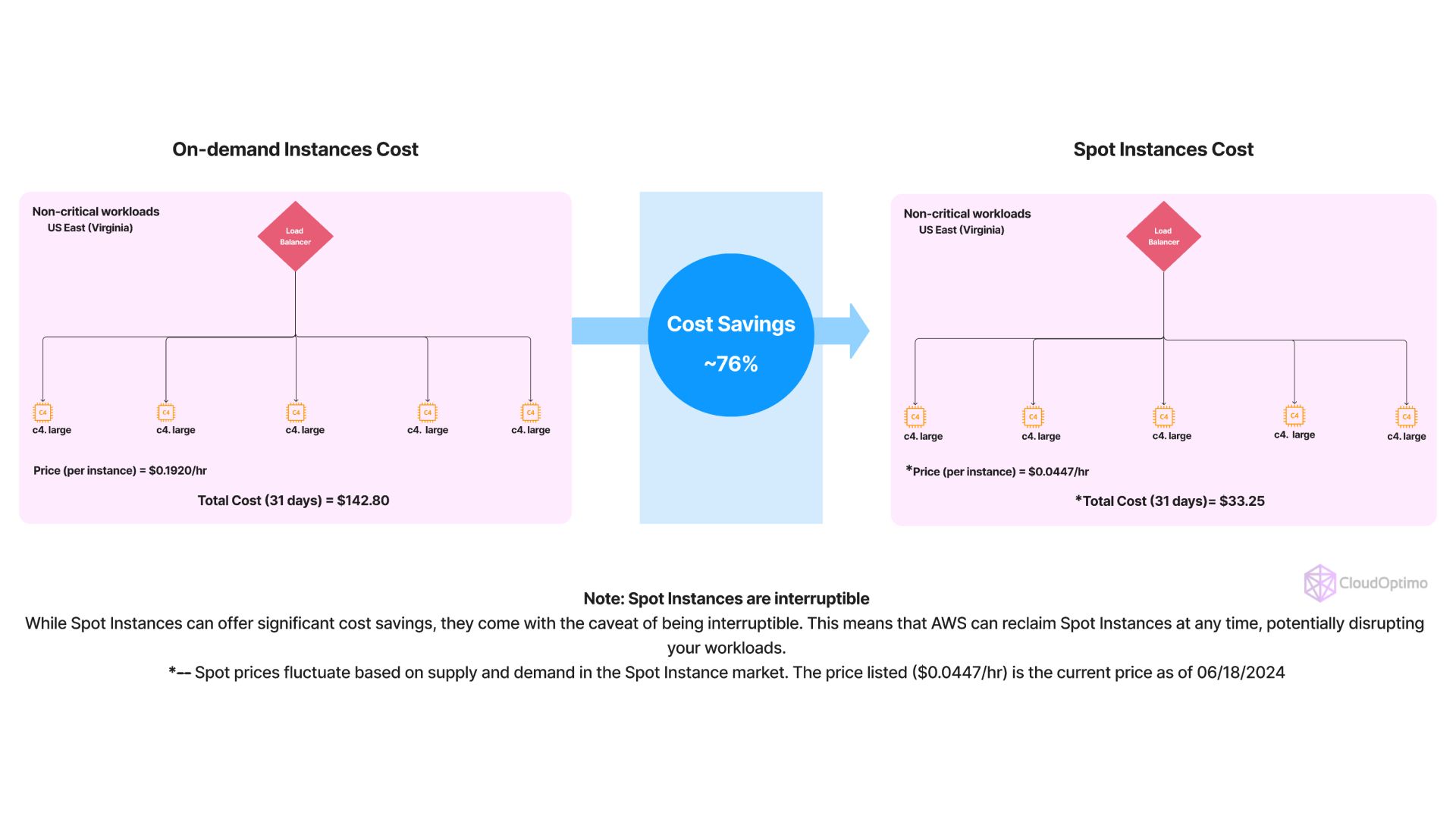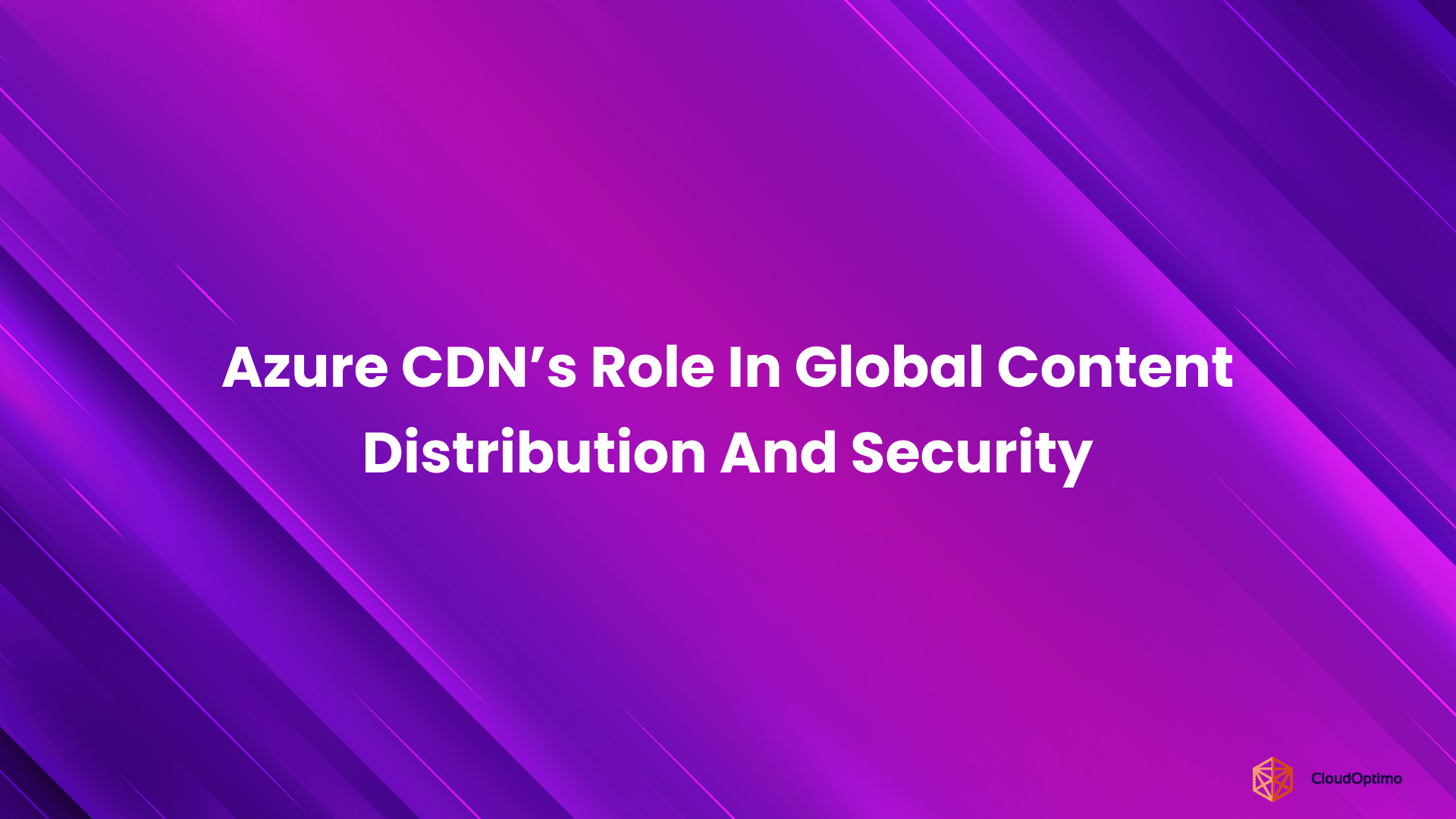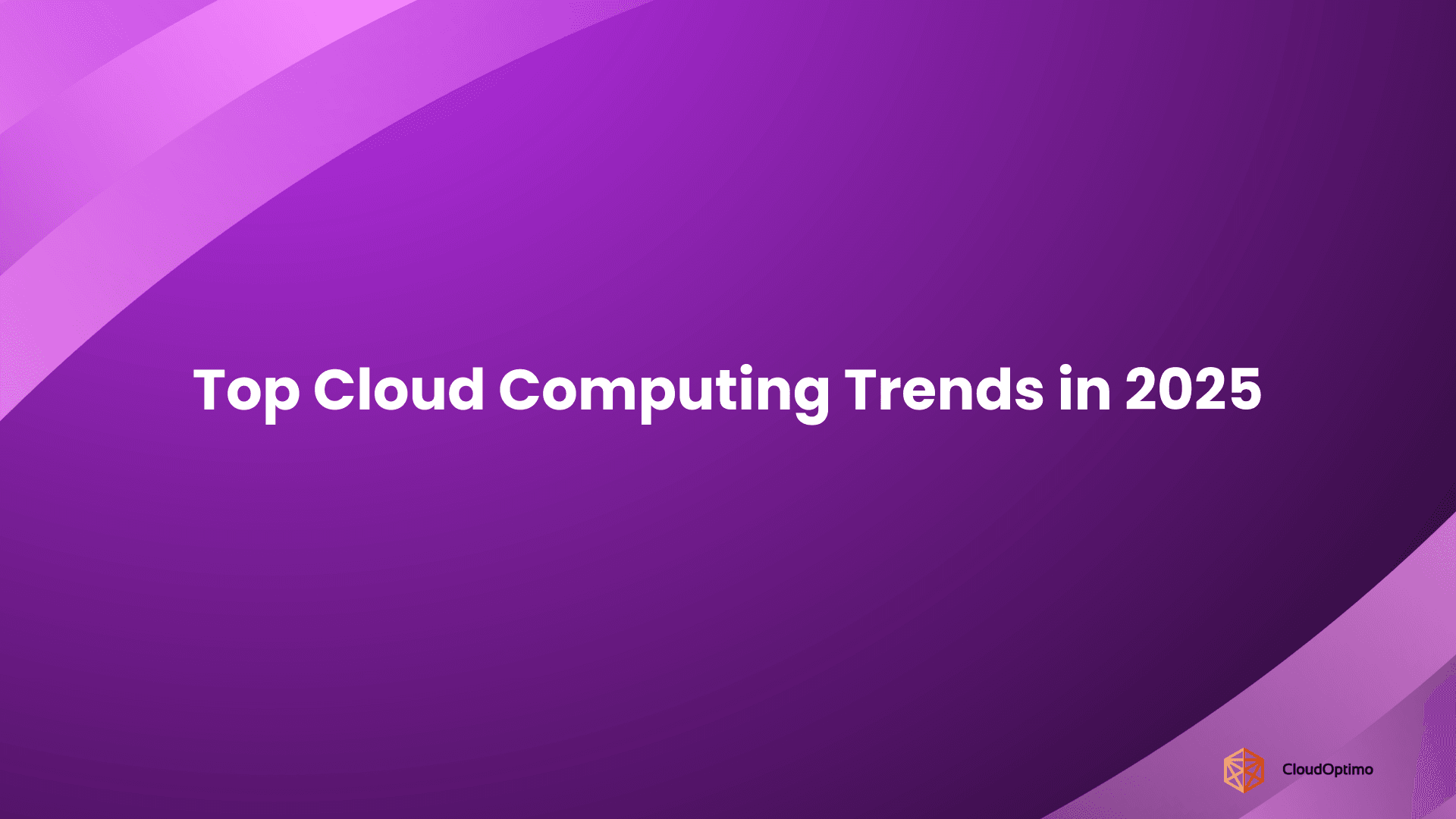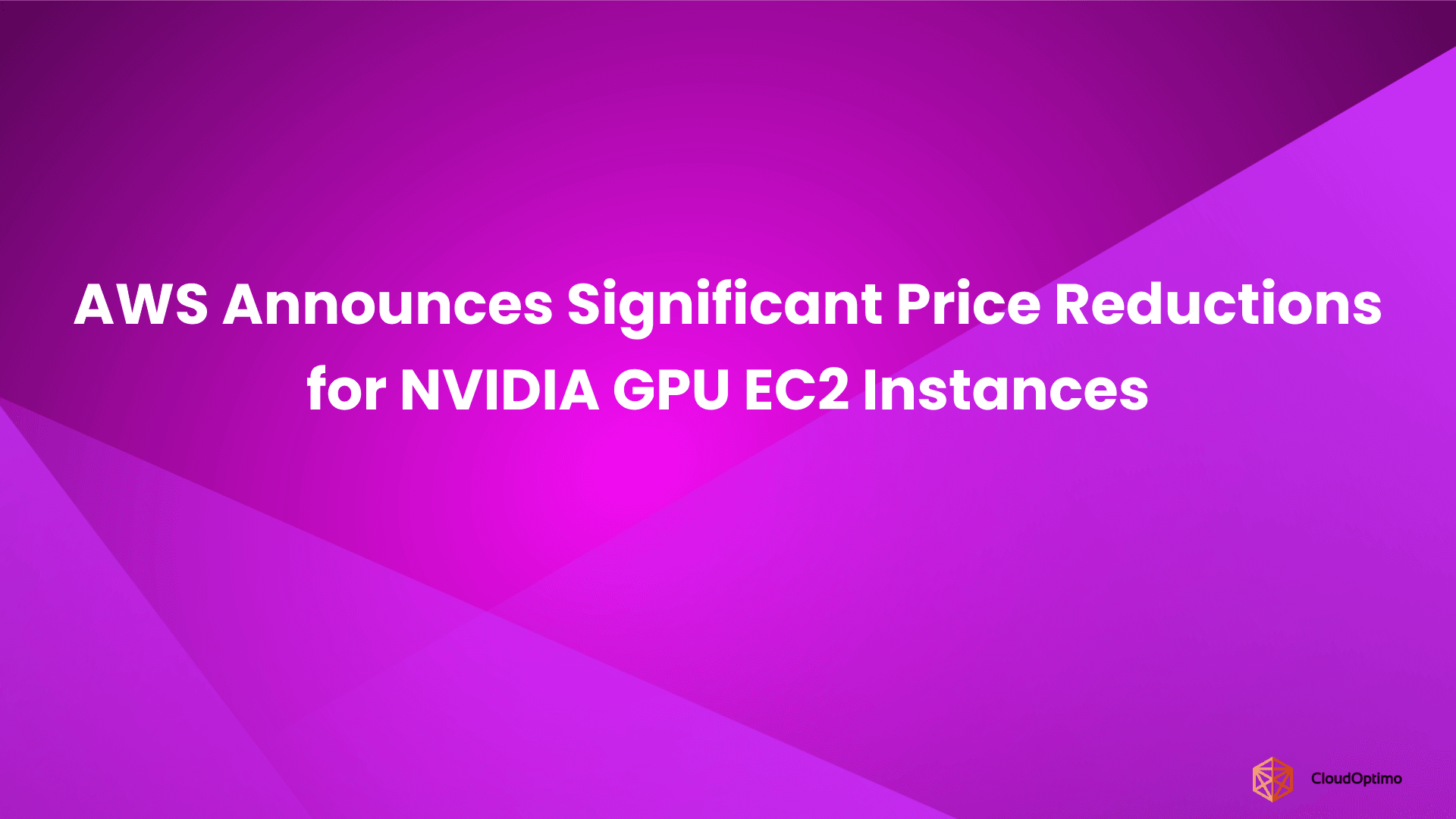Introduction
Selecting the right compute resources in the cloud is crucial for optimizing both cost and performance. Within the vast Amazon Web Services (AWS) EC2 landscape, On-Demand and Spot Instances stand out as popular options. This blog dives deep into these two instance types, explaining their functionalities, advantages, limitations, and ideal use cases. We'll equip you to make informed decisions for your cloud deployments by highlighting the key differences between On-Demand and Spot Instances and exploring practical scenarios where each shines. The two main pricing models for AWS instances are:
- On-Demand Instances: Pay per hour (or second) for the instance you use.
- Spot Instances: Bid on spare EC2 capacity for significantly lower prices, but with the possibility of interruption.
What are On-Demand Instances?
On-demand instances are the foundation of AWS EC2 service. They offer a pay-as-you-go model for cloud computing resources, making them a reliable and predictable choice for your applications.
Pros of On-demand Instances
- Predictable Pricing: Unlike Spot Instances, with On-Demand Instances, you know exactly what you'll be paying. AWS charges a fixed hourly rate based on the specific instance type you choose. This makes budgeting for your cloud infrastructure significantly easier. You can estimate your costs upfront and avoid any surprise charges.
- Guaranteed Availability: One of the biggest strengths of On-Demand Instances is their reliability. AWS guarantees that these instances will always be available when you need them. This is crucial for mission-critical applications that require consistent uptime, such as your e-commerce platform or customer relationship management (CRM) system. There's no risk of your instances being interrupted because of fluctuating market conditions.
- Full Control: With On-Demand Instances, you have complete autonomy over your resources. You can start, stop, or terminate your instances at any time. This level of control allows you to manage your cloud environment efficiently and optimize costs. For instance, you can stop unused instances during off-peak hours to avoid unnecessary charges.
- Scalability: On-demand instances provide outstanding flexibility for scaling your computing resources. This means you can easily adjust the amount of processing power you have available (up or down) to match the changing needs of your applications. Imagine a sudden surge in traffic on your website - with on-demand instances, you can quickly add more instances to handle the increased workload. Conversely, during quieter periods, you can scale down the number of instances you're using to optimize costs.
- Wide Variety of Instance Types: AWS offers a vast array of On-Demand Instance types, each optimized for specific tasks. Whether you need a compute-intensive instance for complex calculations, a memory-intensive instance for large datasets, or a GPU-accelerated instance for machine learning applications, there's an On-Demand Instance type to fit your needs. This variety ensures you have the right tools for the job.
- Cons Of On-demand instances
- Higher Cost: Compared to Spot Instances, On-Demand Instances are generally more expensive. You're paying a premium for the guaranteed availability and predictability they offer. This might not be the most cost-effective option for workloads that are not constantly running or can tolerate interruptions.
- Less Cost-Effective for Idle Workloads: If you have applications that are only used occasionally, On-Demand Instances might not be the most economical choice. Since you're charged by the hour, even for idle instances, you could be paying for resources you're not actively using. In such cases, exploring Spot Instances or other options like Reserved Instances might be more cost-effective.
When to use On-demand instances?
Mission-Critical Applications:
Process: Your business relies on core applications like an e-commerce platform or CRM system to operate continuously. These applications handle essential tasks like processing customer orders, managing customer data, and facilitating communication.
Challenges of Spot Instances: Spot Instances are not suitable for mission-critical applications because they can be interrupted with a 2-minute notice. This interruption could lead to:
- Downtime: The application becomes unavailable to users, potentially causing lost revenue or hindering customer service.
- Data Loss: If the application is writing data during the interruption, there's a risk of incomplete or corrupted data.
- Inconsistent Performance: Spot Instances may experience variable performance depending on available capacity, leading to slowdowns or glitches in the application.
Benefits of On-Demand Instances: On-Demand Instances provide the guaranteed performance and availability needed for mission-critical applications. They act like an uninterruptible power supply (UPS) for your cloud applications:
- Consistent Resources: You have full control over the instance and can ensure it has the necessary resources to run smoothly at all times.
- High Availability: On-demand instances offer a high uptime guarantee, minimizing the risk of unplanned downtime that could disrupt your business.
- Predictable Performance: Consistent performance ensures your applications function reliably and deliver a smooth user experience.
Example: E-commerce Platform During Peak Season:
An e-commerce platform experiences a surge in traffic during peak season (e.g., holidays). On-demand instances are ideal for ensuring the platform's stability and functionality throughout this critical period. They guarantee:
- Smooth Customer Experience: Customers can browse product catalogs, add items to carts, and complete purchases without encountering slowdowns or errors due to resource limitations.
- High Order Processing Capacity: The platform can handle a high volume of orders efficiently, minimizing processing delays and ensuring timely order fulfillment.
- Uninterrupted Sales: Consistent availability prevents revenue loss due to unexpected downtime during peak sales periods.
For mission-critical applications, prioritize the reliability and predictability of On-Demand Instances. This ensures your core business functions operate without interruption.
Unpredictable Workloads:
Process: Imagine running an e-commerce website. Traffic can fluctuate significantly, with surges during peak sales seasons, flash promotions, or marketing campaigns. You need to be prepared to handle these unpredictable spikes in demand.
Challenges of Spot Instances:
- Unreliable Availability: Spot Instances can be interrupted with a 2-minute notice, potentially disrupting your website during peak traffic periods. This may lead to a loss of sales and leave customers dissatisfied.
- Unpredictable Pricing: Spot instance pricing fluctuates based on demand. During peak periods, prices may increase significantly, potentially negating the cost savings you aimed to achieve.
Challenges of Reserved Instances:
- Over-Provisioning: If you reserve instances to handle peak traffic, you may end up with idle resources during off-peak times. This can lead to wasted spend if you're not utilizing the full capacity of your reserved instances.
- Limited Scalability: Scaling up reserved instances can take time and effort. Provisioning additional reserved instances takes time and may not be feasible for short-term spikes in demand. Scaling down reserved instances typically incurs early termination fees, making it less flexible for adjusting to changing workloads.
Benefits of On-Demand Instances:
- Elastic Scaling: On-demand instances offer on-demand scalability. You can easily provision additional instances to handle surges in traffic and terminate unused instances when demand subsides.
- Pay-As-You-Go Pricing: You only pay for the resources you use. This eliminates the risk of wasted spend on underutilized reserved instances during off-peak times.
- Cost Savings: Compared to reserving excess capacity or risking disruptions with Spot Instances, On-Demand allows you to pay for resources only when needed, leading to significant cost savings for unpredictable workloads.
Example: E-commerce Website with Flash Sales
An e-commerce website experiences a predictable surge in traffic during its weekly flash sale event. Traffic can jump by 5x compared to normal days. Here's how On-Demand Instances can be beneficial:
- Automatic Scaling: The website can be configured to automatically scale up by provisioning additional On-Demand Instances during the flash sale. This ensures the website can handle the increased traffic and maintain a fast browsing experience for customers.
- Pay-Per-Use: The website only pays for the additional instances used during the flash sale period. During regular days, the website can scale down to a minimal number of instances, minimizing costs.
- Flexibility: On-demand instances offer the flexibility to adapt to unpredictable traffic patterns. The website isn't locked into a set amount of reserved capacity, allowing it to scale up and down as needed.
- Cost-Effective Compared to Other Options:
- Reserving instances for peak traffic would lead to underutilized resources during off-peak times.
- Spot Instances could be interrupted during the sale, leading to lost sales and customer frustration.
For unpredictable workloads, the on-demand pricing and elastic scaling capabilities of On-Demand Instances provide the agility and cost-efficiency needed to handle surges in demand without compromising performance or availability.
Development and Testing:
Process: Building and testing applications is an iterative process. Developers need environments to write code, conduct tests, and refine features. These environments require consistent performance and reliable availability to ensure efficient development workflows.
Challenges of Spot Instances: While Spot Instances offer significant cost savings, they introduce challenges for development and testing:
- Unpredictable Interruptions: Spot Instances can be interrupted with a 2-minute notice, potentially disrupting testing cycles or causing data loss if tests are in progress.
- Variable Performance: Fluctuations in Spot Instance performance can lead to inconsistent test results, making it difficult to accurately assess application behavior.
- Bid Management Overhead: Setting and managing bids for Spot Instances adds complexity to the development process.
Benefits of On-Demand Instances: On-Demand Instances provide the ideal environment for development and testing due to their predictability and ease of use:
- Predictable Costs: On-demand pricing simplifies budgeting. You know exactly how much your development and testing activities will cost based on instance type and usage duration. This eliminates surprises in your development budget.
- Ease of Use: On-demand instances are straightforward to provision and manage. Developers can quickly spin up instances for specific tests and terminate them when finished. This streamlined approach saves time and effort compared to managing bids and configurations for Spot Instances.
- Guaranteed Availability: On-demand instances offer guaranteed availability, ensuring your development environment is always accessible. This allows for continuous testing and development cycles without worrying about instance interruptions.
Example: Web Application Performance Testing
A development team is building a new e-commerce web application. To ensure optimal user experience, they need to perform thorough load testing to simulate real-world traffic scenarios. With On-Demand Instances, the development team has a predictable testing environment. They can:
- Provision a pool of On-Demand Instances with the same specifications as their production environment.
- Run load testing tools to simulate real-world traffic patterns on these instances.
- Analyze the test results with confidence, knowing the environment remained consistent throughout the testing process.
- Quickly terminate the On-Demand Instances after testing is complete, incurring costs only for the duration of the test.
For development and testing, prioritize the efficiency and predictability offered by On-Demand Instances. This ensures a smooth development workflow and simplifies cost management.
Applications Requiring Specific Hardware:
Process: Some applications have specialized hardware needs to function properly. These needs may not be met by the ever-changing pool of instance types available on the Spot market.
Challenges of Spot Instances: Spot Instances offer a broad range of instance types, but availability can fluctuate. There's no guarantee a specific hardware configuration, like a GPU, will always be available when needed. This can lead to:
- Incompatibility Issues: If the required hardware isn't available on the Spot market, your application cannot launch or function properly.
- Performance Bottlenecks: Using a Spot Instance with insufficient hardware can lead to performance issues, slowing down your application.
- Launch Delays: Waiting for a specific Spot Instance type with the necessary hardware can delay application launch times.
Benefits of On-Demand Instances: On-Demand Instances offer a wider selection of instance types with various hardware configurations. You can choose the exact instance type that meets your application's specific needs. This guarantees:
- Hardware Compatibility: You have full control over the instance type, ensuring it has the required hardware (e.g., GPU) for your application to run smoothly.
- Optimal Performance: Matching your application's hardware requirements with the right On-Demand Instance type helps achieve optimal performance and avoid bottlenecks.
- Predictable Launches: On-demand instances are always available, so you can launch your application with the necessary hardware configuration whenever needed.
Example: Scientific Simulations
Scientific research often relies on complex simulations that require significant processing power and specialized hardware like GPUs. These simulations can take hours or even days to run.
Using Spot Instances for such workloads would be risky. A Spot Instance interruption mid-simulation could lead to lost progress and wasted compute resources. On-demand instances offer a more reliable solution:
- Guaranteed GPU Availability: Choose an On-Demand Instance type with a GPU to ensure the necessary hardware is available for the entire simulation duration.
- Uninterrupted Processing: On-Demand Instances provide a predictable runtime environment, minimizing the risk of interruptions that could corrupt simulation data.
- Optimal Performance: Matching the simulation's hardware requirements with a powerful On-Demand Instance ensures the calculations run efficiently and deliver results faster.
For applications requiring specific hardware, prioritize the guaranteed compatibility and control offered by On-Demand Instances. This ensures your application has the resources it needs to function optimally without compatibility concerns or launch delays.
What are Spot Instances?
Spot Instances are a cost-effective option that uses spare EC2 capacity. You bid a price, you're willing to pay for an instance type, and if your bid exceeds the current Spot price, your instance launches.
Pros of Spot Instances
- Significant Cost Savings:
- Spot Instances can be up to 90% cheaper than On-Demand Instances for the same computing power. This is because you're essentially bidding on unused capacity that AWS needs to offload.
- This translates to huge cost reductions for workloads that can tolerate interruptions. Imagine running a large data analysis job overnight – using Spot Instances can save you a significant amount compared to keeping an On-Demand Instance running all night.
- Scalability:
- Spot Instances offer elastic scaling. You can easily adjust your resource needs by simply changing your bids. Need to process a larger dataset? Increase your bids to acquire more Spot Instances. Traffic to your web application spikes? Scale up your web servers running on Spot Instances to handle the demand.
- This allows you to pay only for the resources you actually use, maximizing cost efficiency.
- Significant Cost Savings:
Cons of Spot Instances
- Interruptible: The biggest drawback of Spot Instances is their interruptibility. AWS can reclaim the underlying compute resources if they're needed for On-Demand Instances. This means your Spot Instance can be terminated at any time, potentially disrupting your workload.
- Unpredictable Pricing: Spot prices are constantly fluctuating based on supply and demand for spare capacity. This makes it difficult to predict your exact costs upfront. However, AWS provides tools like Spot Instance historical pricing charts and interruption forecasts to help you make informed decisions.
- Limited Control: You don't have control over when a Spot Instance interruption might occur. This can be a challenge for applications that require continuous operation. However, there are strategies to mitigate this, such as using Spot Fleet with multiple instances across different Availability Zones to minimize the chance of all instances being interrupted simultaneously.
When to use Spot Instances?
Batch-processing
Many applications process large datasets or perform complex calculations in batches, often overnight or during off-peak hours. These tasks are inherently fault-tolerant – if a Spot Instance interruption occurs mid-process, the job can simply be restarted with minimal impact. Spot Instances provide a cost-effective way to handle these batch workloads, significantly reducing infrastructure costs compared to On-Demand Instances.
Example: E-commerce Order Fulfillment (Amazon):
Process: Throughout the day, customer orders flow in from the website and mobile app. These orders are collected in a database.
- Batch Processing: At designated times (e.g., evenings), a batch processing program kicks in. It groups orders by location, delivery urgency, and product availability. This allows for:
- Route Optimization: Delivery routes are planned for maximum efficiency, minimizing driver travel time and fuel consumption.
- Warehouse Automation: Picking and packing robots or staff can be prepped for specific batches of items, streamlining the process.
- Benefits: Faster fulfillment times, lower delivery costs, and efficient use of warehouse resources.
- Batch Processing: At designated times (e.g., evenings), a batch processing program kicks in. It groups orders by location, delivery urgency, and product availability. This allows for:
Web Scraping on a Budget
Web scraping, the process of extracting data from websites for various uses like market research or price comparisons, is often non-critical and can be easily resumed after interruptions. This makes Amazon's Spot Instances a compelling option for these tasks. Spot Instances offer a cost-effective way to leverage spare compute capacity on the AWS cloud, enabling businesses to gather valuable data without exceeding their budget.
Web scraping tasks are often:
- Non-critical: Temporary interruptions won't cause major problems. Scraped data can be partially retrieved later.
- Restartable: Scraping jobs can be restarted from scratch or from a checkpoint if interrupted by a Spot Instance termination.
Benefits:
- Cost-effective: Spot Instances significantly reduce infrastructure costs compared to On-Demand Instances for web scraping.
- Scalable: Easily scale scraping operations up or down based on needs by launching or terminating Spot Instances.
Example: A travel agency wants to scrape competitor pricing information to stay competitive. Spot Instances allow them to:
- Run scraping scripts on Spot Instances to collect competitor data.
- Store scraped data in a persistent storage solution (e.g., S3) to ensure data isn't lost during interruptions.
- Develop scripts to handle interruptions gracefully and resume scraping from the last retrieved point.
Scientific Simulations with Flexibility
Scientific simulations often involve complex calculations that can take hours or even days to complete. While these simulations require significant processing power, they can often tolerate interruptions. Spot Instances can be a budget-friendly option for running these simulations, allowing researchers to achieve their scientific goals without straining their budgets.
Scientific simulations are often:
- Flexible with interruptions: Simulations can be paused and resumed from checkpoints if a Spot Instance is interrupted.
- High processing power needs: Spot Instances provide scalable access to computing resources for computationally intensive tasks.
Benefits:
- Cost-effective: Spot Instances significantly reduce the cost of running scientific simulations compared to On-Demand Instances.
- Faster time to results: Utilize the parallel processing power of Spot Instances to complete simulations quicker.
Example: A research team is simulating protein folding to understand disease processes. Spot Instances enable them to:
- Launch Spot Instances with appropriate configurations for the protein folding simulation software.
- Design the simulation program to save progress at regular intervals, allowing for resumption in case of interruptions.
- Leverage the parallel processing power of Spot Instances to accelerate the simulation.
Additional Considerations for Spot Instances
- Spot Instance Fleets: Launch and manage a group of Spot Instances to improve availability and spread risk across multiple instances.
- Spot Instance Interruption Handling: Design your applications to handle interruptions gracefully or use strategies like auto-scaling to launch new instances when existing ones are interrupted. For example, you can use CloudOptimo’s OptimoGroup & OptimoMapReducer to utilize spot instances and be worry-free about the interruptions spot instances face.
- Spot Instance Pricing History: Use cloud provider tools to view historical pricing trends for specific instance types in your desired region. This can help you set appropriate bid prices.
Choosing Between On-Demand and Spot Instances
The optimal choice between On-Demand and Spot Instances depends on your specific needs and priorities.

| Feature | On-Demand Instances | Spot Instances |
| Pricing | Consistent, pay per second | Variable, bid-based pricing. Up to 90% cheaper than on-demand |
| Availability | Guaranteed | Not guaranteed. Instances can be interrupted with a 2-minute notice |
| Performance | Predictable and consistent | Performance can vary depending on available capacity |
| Control | Full control over instance start/stop/terminate | Limited control. Users cannot control interruptions |
| Use Cases |
|
|
Exploring Additional Options
Beyond On-Demand and Spot Instances, the EC2 service offers options that can provide significant cost savings for predictable workloads:
Reserved Instances (RIs):
Concept: RIs offer significant discounts (up to 72%) compared to On-Demand pricing for a specific instance type (family, generation, size, OS, region, and tenancy) in exchange for a commitment to use that instance for a set period (1 or 3 years).
- Considerations:
- Commitment: RIs require an upfront payment or commitment to hourly usage over the term. This can be inflexible if your needs change.
- Granularity: RIs are tied to a specific instance type configuration, limiting some flexibility in instance selection.
Savings Plans:
Concept: Savings Plans offer discounts (up to 72%) for committed use of a variety of EC2 instance types or services (including Fargate and Lambda) over a one- or three-year term. Unlike RIs, Savings Plans apply to your overall EC2 spending within a chosen scope (entire region, specific instance family, or a mix of both).
- Considerations:
- Commitment: Savings Plans require a commitment to spend a certain amount per hour over the term. This can be less rigid than RIs as unused commitment applies to other eligible usage.
- Monitoring Usage: You need to monitor your spending to ensure you use enough committed hours to maximize the Savings Plans benefit.
By understanding the strengths and limitations of On-Demand & Spot, you're now equipped to make informed decisions about powering your cloud environment. Remember, the ideal choice depends on your specific needs and priorities. Here's a quick recap to help you navigate the EC2 landscape:
- Rock-solid reliability and predictable pricing: Go with On-Demand Instances.
- Applications can handle interruptions with cost savings: Spot Instances are your answer.
- Specific instance type for a sustained period: Explore Reserved Instances for significant savings.
- Flexible discounts across a variety of EC2 resources: Savings Plans might be the way to go.
The key is to find the right combination of options to create a cost-optimized and powerful cloud environment that perfectly aligns with your needs. Fine-tune your strategy as your requirements evolve.





